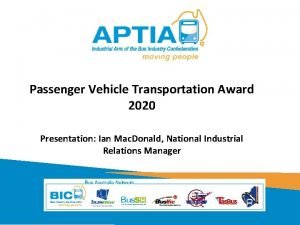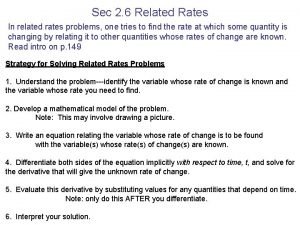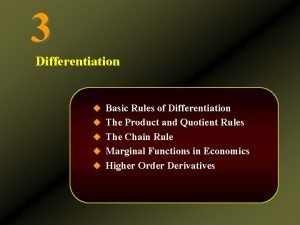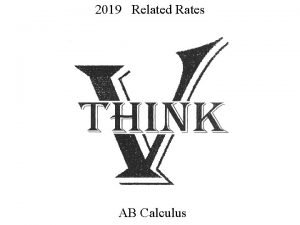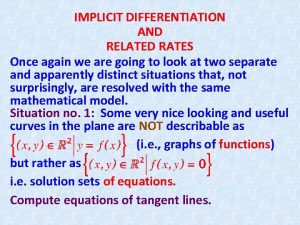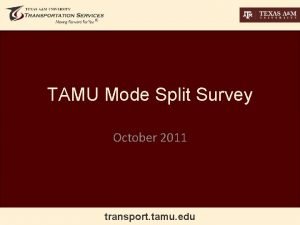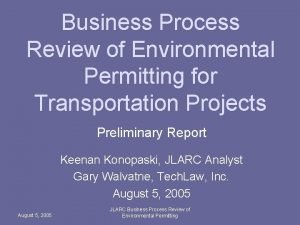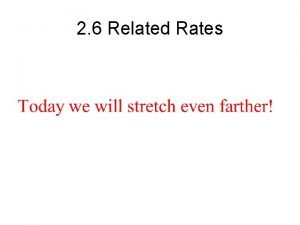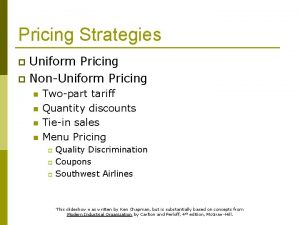Transportation Pricing CharacterofShipment Rates Special rates related to





















- Slides: 21

Transportation Pricing

Character-of-Shipment Rates • Special rates related to the size or character of the shipment • Carriers generally have certain fixed costs for each shipment • Includes: – LTL/TL Rates – Multiple-car Rates – Incentive Rates – Unit-train Rates – Per-car & Per-truckload Rates – Any-quantity Rates – Density Rates

Character-of-Shipment Rates • LTL/TL Rates – LTL shipments require multiple handlings – Each handling requires dock personnel, materialshandling equipment, terminal investment & additional communications/tracking efforts – Thus, higher rates for LTL shipments – TL shipments are generally loaded by the shipper, moved intact to destination, & unloaded by consignee. – No intermediate handlings required – No intermediate terminals required – Thus, lower rates for TL shipments

Character-of-Shipment Rates • Multiple-car Rates – Railroad special rate – Volume discount for moves of more than one carload that are shipped as a single string of cars from one point to another – Cost of moving multiple cars in single shipment proportionally less than cost of each car moved singly – Multiple cars can be handled by same effort as a single-car shipment • • Empty car drop-off Pickup Delivery efforts Documentation – Only basic difference is the additional weight moved

Character-of-Shipment Rates • Incentive Rates – Rate designed to induce shipper to load existing movements and equipment more fully – Usually apply only to weight or units loaded over and above normally shipped quantities – Fewer cars and moves are required over the course of a year, though same actual volume is shipped – Example • Appliance manufacturer typically ships carload quantities that only fill car to 80% of capacity • Minimum carload rate is 40, 000 lbs; capacity 60, 000 lbs • Manufacturer normally only loads 48, 000 lbs. • Incentive rate would apply to the additional 12, 000 lbs.

Character-of-Shipment Rates • Unit-train Rates – Integrated movements between an origin & destination – Trains usually avoid terminals & do not require intermediate switching or handling of individual cars – Shipper or consignee typically provides the railcars

Character-of-Shipment Rates • Per-car & Per-truckload rates – Single-charge rates for specific origin-destination moves regardless of shipment commodity or weight – Also apply to container movements where carriers’ costs of movement dominated by moving the equipment & not specifically by shipment weight

Character-of-Shipment Rates • Any-quantity Rates – AQ rates provide no discount or rate-break for larger movements • LTL rates exist but no TL rates for large shipments – Apply to any weight in a shipment – Usually used for shipment of large, bulky commodities such as boats, suitcases, and cages where no economies are realized by the carrier for larger shipments

Character-of-Shipment Rates • Density Rates – Rates published by density of the shipment and its weight, not by commodity or weight alone – Common in air carrier shipments – Applied when carrier assesses rates on basis of weight, but does not experience fewer costs for lighter-weight containers

Area, Location, or Route Rates • Includes: – Local rates – Joint rates – Proportional rates – Differential rates – Per-mile rates – Terminal-to-Terminal rates – Blanket or Group rates

Area, Location, or Route Rates • Local Rates – Apply to any rate between 2 points served by the same carrier – Include full-cost factors for pickup, documentation, rating, billing, and delivery • Joint Rates – Single rates published from a point on one carrier’s route to another carrier’s destination – Usually lower in total charges than the combination of local rates

Area, Location, or Route Rates • Proportional Rates – Some carriers at competitive disadvantage when they compete with other more direct lines – Carrier might publish a proportional or lower rate than its regular local rate that applies only to through moves to certain destination points beyond its line

Area, Location, or Route Rates • Differential Rates – Published rate by a carrier that faces a service time disadvantage compared to a faster carrier or mode • Water carriers often publish differential rates lower than regular rates of railroads – Lower rate offsets somewhat the longer transit time disadvantage

Area, Location, or Route Rates • Per-mile Rates – Rates based purely upon the mileage involved – Generally used in situations in which weight of shipment of lower significance • Terminal-to-Terminal Rates – Ramp-to-ramp rates that require shipper and consignee to perform the traditional pickup and delivery functions

Area, Location, or Route Rates • Blanket or Group Rates – Apply to or from whole regions rather than points – All shipments coming from (going to) a region are treated as coming from (going to) the same point of origin (destination) – Example • All lumber shipments from Oregon & Washington are treated as having the same origin • Food shipments from California & Florida treated similarly

Time/Service Rates • Generally dependent on the transit time performance of the carrier in a particular service • Shipper pays a higher rate for faster service & lower rate for slower – Reduced rates offered for certain minimum tonnage shipped over a specified period – Deferred delivery contracts in which carrier charges lower rate for privilege of deferring arrival time of shipment • Air expresses companies offer 25% discount or more for second - or third-day delivery as opposed to next-day delivery • Gives carrier more operating flexibility

Other Rate Structures • Corporate Volume Rates – Discounted rate for each LTL shipment that is related to the total volume of LTL shipments that a firm ships via a specific carrier from all shipping points – More volume shipper tenders to a particular carrier, the greater the discount – Not widely used today

Other Rate Structures • Discounts – LTL shipments of a specific commodity class moving between given origins and destinations • Loading Allowances – Reduced rate or discount granted if shipper loads LTL shipments into carrier’s vehicle • Aggregate Tender Rates – Reduced rate or discount granted if shipper tenders 2 or more class-rated shipments to the carrier at one time – Aggregate usually must equal 5000 lbs minimum – Tender of 2 or more reduces number of times carrier goes to shipper’s facility to pickup cargo

Other Rate Structures • FAK Rates – All-commodity rates expressed in cents per hundredweight or total cost per shipment – Rate based on cost of service, not the commodity hauled – Involves mixed commodities shipments – Generally used in shipment of groceries

Other Rate Structures • Empty-haul Rates – Charge for moving empty rail or motor equipment that is owned or leased by or assigned to a particular shipper – Induces shipper to fully load all miles of the equipment movements • 2 -way or 3 -way Rates – Apply to rates that are constructed and charged when backhaul or triangular moves can be made – Intent is to tie a fronthaul move with what would have been another firm’s backhaul.

Other Rate Structures • Spot-Market Rates – Special rate offered to facilitate movement of equipment or product – Generally used if excess supply of empty trailers begins accumulating in a geographic region • Menu Pricing – Allows a shipper to pick and choose those services the carrier should perform – Requires the carrier to understand know its costs of providing various services on the “menu. ”
 Passenger transport award
Passenger transport award Ratios rates and unit rates
Ratios rates and unit rates Ratios rates and unit rates
Ratios rates and unit rates Is a ratio a rate
Is a ratio a rate Ratios and proportions guided notes
Ratios and proportions guided notes Related rates right triangle
Related rates right triangle Solve
Solve Related rates baseball diamond
Related rates baseball diamond General power rule
General power rule Related rates intro
Related rates intro Related rates intro
Related rates intro Implicit differentiation and related rates
Implicit differentiation and related rates Two types of physical
Two types of physical Skill related fitness vs health related fitness
Skill related fitness vs health related fitness Hazardous waste transportation
Hazardous waste transportation Fleet loader
Fleet loader Transport tamu
Transport tamu Egusd transportation
Egusd transportation Transportation business reengineering
Transportation business reengineering What are the advantages of water transport
What are the advantages of water transport Secure transportation pakistan
Secure transportation pakistan Paulding county bus locator
Paulding county bus locator
